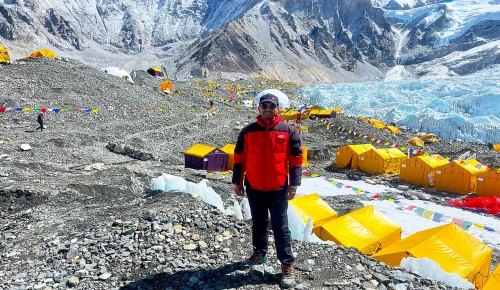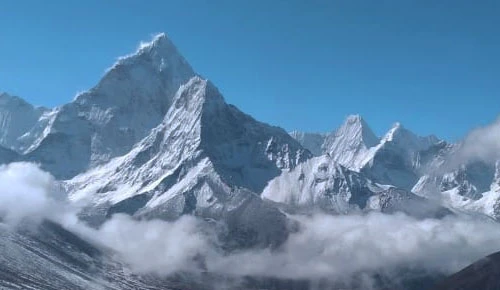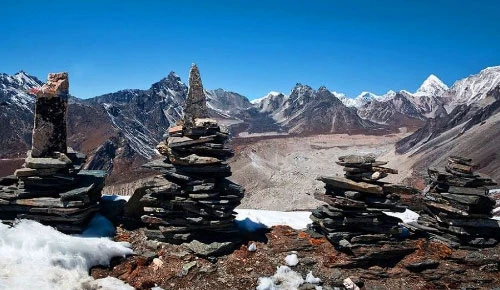Everest Base Camp Heli Out Trek
Everest base camp flyout trek is a unique and thrilling adventure that combines the convenience of flying into the Everest region with the awe-inspiring experience of trekking to the famous base camp of Everest. This concept allows trekkers to maximize their time and energy by avoiding the long and strenuous trek from the lower regions of Nepal to reach the starting point of the trek.
Located in the Khumbu region of Nepal, Everest is the highest peak in the world, standing tall at an astonishing 8,848.86 meters (29,029 feet). The Everest region has captivated the hearts and minds of adventurers and nature enthusiasts for decades, offering breathtaking landscapes, challenging terrain, and a rich cultural heritage.
The popularity of the Khumbu region is unparalleled, drawing thousands of trekkers each year who seek to conquer base camp and witness the magnificent beauty of the Himalayas. With its soaring peaks, dramatic valleys, and picturesque villages, the region offers a once-in-a-lifetime experience that combines natural beauty with a sense of personal achievement.
Table of Contents
Advantages
Here is the list of advantages of this Everest Heli Flyout Trekking package:
- Spectacular views of Mount Everest and surrounding peaks.
- Time-efficient trek, starting at a higher elevation after a scenic flight to Lukla.
- Avoids long bus rides from Kathmandu.
- Diverse terrain, including forests, Sherpa villages, and glacial valleys.
- Immersion in Sherpa culture and traditions.
- Fewer crowds compared to lower region treks.
- Flexible itinerary customization
- Experienced guides and porters ensure safety.
- Accessible tea houses and lodges along the route.
- Adventure and sense of achievement in reaching Everest Base Camp.
Best Season for Heli Out Trek
This trek is a breathtaking adventure that takes you to the iconic base camp. Choosing the right season for this trek is crucial to ensuring a safe and enjoyable experience. The best seasons for the Everest flyout trek are generally considered to be the spring (March to May) and autumn (September to November). During these seasons, the weather is relatively stable, with clear skies, mild temperatures, and less precipitation.
The spring season offers vibrant rhododendron blooms and lush green landscapes, while the autumn season showcases clear mountain views and favorable trekking conditions. These seasons also coincide with the peak climbing seasons, allowing trekkers to witness the vibrant mountaineering atmosphere around Everest. It's important to note that while these seasons are popular, the Everest region can still be crowded with trekkers.
However, with proper planning and booking in advance, you can make the most of these seasons and enjoy the Everest flyout trek to its fullest.
Preparation
- Choose the right time for the flyout trek, considering weather conditions and availability of flights.
- Obtain necessary permits and paperwork, such as the Sagarmatha National Park Entry Permit and TIMS (Trekkers' Information Management System) card.
- Pack essentials for the trek, including proper trekking gear, warm clothing, sturdy footwear, a backpack, toiletries, and a first aid kit.
- Research the best time to fly into Lukla, the gateway to Everest, to ensure smooth travel logistics.
- Book a flight to Lukla's Tenzing-Hillary Airport, known for its thrilling and scenic flight experience.
- Prepare for the acclimatization process in Lukla, which is essential for adjusting to the high altitude.
- Familiarize yourself with the trekking route and itinerary, ensuring you have a clear understanding of the distances, landmarks, and daily schedules.
- Take note of the scenic highlights along the way, such as Namche Bazaar, Tengboche Monastery, and Khumbu Icefall.
- Be aware of the challenges and precautions during the trek, including altitude sickness, steep ascents and descents, and unpredictable weather conditions.
- Consider staying in teahouses along the trail, which provide basic accommodations and meals for trekkers.
- Arrive at Base Camp and immerse yourself in the majestic views and serenity of the surroundings.
- Respect the climbers and Sherpas, understanding the significance of their efforts and the teamwork involved.
- Practice responsible tourism and sustainable trekking practices to minimize your impact on the environment.
- Research fitness and training preparations to ensure you are physically prepared for the demanding trek.
- Learn about altitude sickness prevention and management techniques, and listen to your body throughout the trek.
- Explore communication and connectivity options during the trek, such as local SIM cards or satellite communication devices.
- Consider hiring a guide and/or porter to enhance your trekking experience and provide local knowledge and support.








